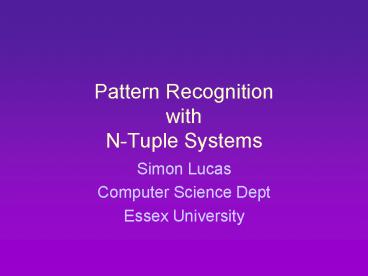Pattern Recognition with N-Tuple Systems PowerPoint PPT Presentation
1 / 34
Title: Pattern Recognition with N-Tuple Systems
1
Pattern RecognitionwithN-Tuple Systems
- Simon Lucas
- Computer Science Dept
- Essex University
2
Overview
- Standard Binary n-tuple
- Dealing with grey-levels
- Continuous n-tuple
- Bit-plane decomposition
- Dealing with sequences
- Scanning N-Tuple
- Future Directions
3
N-Tuple Systems
- Bledsoe Browning (late fifties)
- Sample a pattern at m sets of n-points per set
- Use each sample set to represent a memory address
- Have an n-tuple bank for each pattern class
- Simple training
- Note address occurrences for each class
4
What to store
- Various options
- 1-bit address occurred or not
- Freq weighted count number of occurs
- Prob. use count to estimate probability
- 1-bit version saturates
- Usually better to use probabilistic version (ML
estimate)
5
N-Tuple Architecture
6
Standard N-Tuple Features
- Superfast training
- As fast as you can read the data in!
- Superfast recognition (ditto)
- Simple
- Applicable to binary images
7
Grey-level
8
Threshold?
9
Niblack?
10
Beavis?
11
Continuous N-Tuple
- Samples grey-level image directly
- Pre-compiles samples into LUTs
- Fills LUT entries with ABS distance to closest
sampled point - Recognition speed not compromised
- BUT slower to train
- Memory problems
- Not probabilistic
- Sensitive to spurious training data!
12
Continuous N-Tuple Results
13
Bit-Plane Decomposition
- Alternative to continuous n-tuple
- Uses a combination of binary n-tuple classifiers
- One for each bit-plane (so 8 for 256-grey level)
- Good results reported
- Speed sacrifice
14
Scanning N-Tuple Classifier(SNT)
- Introduced in 1995 (Lucas, Lucas Amiri)
- Since investigated by other research groups (IBM,
Kaist, Kent, Athens) - In a recent study was one of the best classifiers
on UNIPEN dataset - Simple modification of n-gram model
- An n-gram with gaps!!!
15
(No Transcript)
16
Scanning N-Tuple
- Chain code image
- Scan sampler along chain code
- Estimate weights of address occurrences
- Classify by summing weights for each class
- Softmax function -gt posterior probability
- Train
- DEMO!
0
2
3
2
17
Recent Work
- Extensive evaluation (IBM)
- Directional bit-plane decomposition (Kent)
(smaller tables) - Mixture models for table compression (IBM, KAIST)
- Clustering (Athens)
- Discriminative Training (Essex)
- Better accuracy (why????)
18
Terminology
- m frequency count
- l log likelihood weights
- a class activation vector
- y output vector (posterior prob.)
- t target vector
19
Likelihood Score for Class k given Sequence s
20
Softmax Function
- Interpret as posterior probability y_k
21
Maximum Likelihood Est.
22
Discriminative Training
- Maximise probability of correct classification
- Minimise cross-entropy
23
Cross Entropy Error Term
24
Weight Update Rule
If k true class
Apply weight updates
25
Cross-Entropy v. ML
26
Design Process
27
MNIST Results
28
Future Work
- Improve accuracy further
- Mixture Models
- Training data deformation models
- Better understanding of discrim v. ML
- Sparse (e.g. trie) SNT
- Optimal (all) threshold version for colour /
grey-level images
29
Why Mixture?To tell A from B !!!
- A
- 010111000101001
- 010110100010101
- 0101010001011
- 10100101010101
- 010101010001011
- 01010101001010101
- B
- 1111011101111101
- 00010001000001000
- 00001000100010001
- 11110111111011111
- .
30
Why Opti-Thresh?
31
Global Mean Threshold
32
Optimally Thresholded Image
33
Conclusions
- N-Tuple classifiers fantastic speed
- High degree of design skill needed to make them
work well - Compete with much more complex systems
- Interesting future work to be done!
34
Further Reading
- Continuous n-tuple
- Simon M. Lucas , Face recognition with the
continuous n-tuple classifier, Proceedings of the
British Machine Vision Conference (1997) , pages
222 -- 231 pdf - Scanning n-tuple
- Simon M. Lucas and A. Amiri,, Statistical
syntactic Methods for high performance OCR, IEE
Proceedings on Vision, Image and Signal
Processing (1996) , v. 143, pages 23 -- 30 pdf
- Simon M. Lucas , Discriminative Training of the
Scanning N-Tuple Classifier, International
Workshop on Artificial Neural Networks (2003) ,
pages 222 -- 229 pdf (draft) - Plus many more references in those papers
- Search Google for n-tuple and also for scanning
n-tuple

